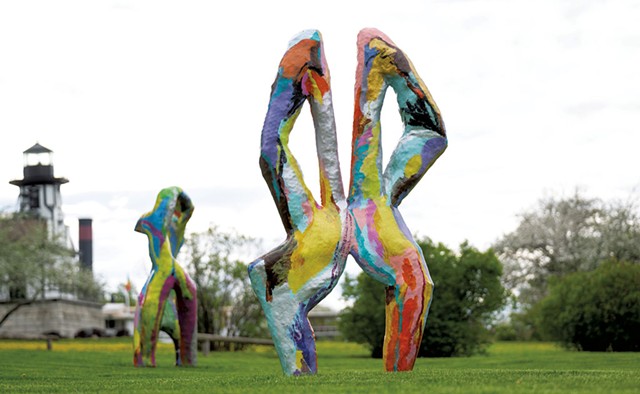
- Courtesy Of Shelburne Museum
- Sculptures by Bianca Beck
The Diana and John Colgate Gallery, the downstairs room of the Pizzagalli Center for Art and Education at Shelburne Museum, has been darkened to evoke the unsettling feel of the exhibition it houses for the summer: "New England Now: Strange States." Dark gray walls enclose the work of 12 artists who explore resonances of New England's tradition of ghostly and macabre tales.
Curator Carolyn Bauer's introductory text sets the mood by referencing the haunting literary works of Edgar Allan Poe, Shirley Jackson and Stephen King. But visitors' first impression of the gallery might instead be of a jewel box: The dark walls beautifully set off works such as Laura Kramer's glittering glass-fragment sculptures, Lauren Fensterstock's massive arrangements of shells and Jennifer McCandless' colorful ceramic works bearing an extraordinary amount of detail. There is a quality of excess to many works in this show — but the kind that delights and draws in visitors only to reveal more disturbing ideas at play.
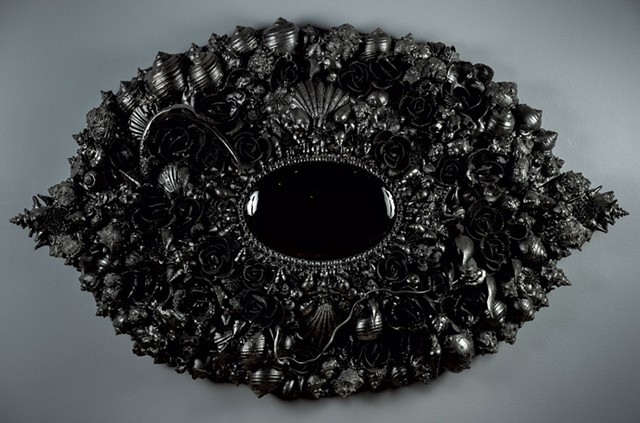
- Courtesy Of Shelburne Museum
- "Scrying 3" by Lauren Fensterstock
"Strange States" is the third exhibition in an ongoing series that began in 2018 with "New England Now," featuring stereotype-defying landscapes, and continued with 2021's "New England Now: People," an exploration of regional identities. Bauer, who curated all three, told a reporter that "the first two felt like prefaces; this one can stand alone." It also happens to feature only female and nonbinary artists — an unplanned result she attributed to being a female curator.
Bauer's intro states that the works don't just open "portals to parallel worlds" but also provide "visitors with new tools and perspectives for exploring the complexities of our reality." The idea is most evident in Boston artist Allison Maria Rodriguez's three video installations, part of her series "Legends Breathe." Based on interviews Rodriguez conducted with female and nonbinary artists, the videos depict fantastical scenarios to help deal with trauma: a tent that can teleport its occupant to any environment, for instance, and a human-size nest watched over by a protective bird of prey. Imagination, Rodriguez suggests, is a useful tool for overcoming pain.
Fensterstock, of Portland, Maine, created three mixed-media works, two in monotone black, that draw the eye between reflective surfaces and depthless matte ones. "Scrying 3," a convex black oval mirror in an elaborate frame of meticulously layered and arranged shells, references two historic practices: using a Claude glass, or black mirror, to observe a landscape with one's back to it — popular with artists and travelers beginning in the 1770s — and scrying, or telling the future using a reflective surface.
There is a too-muchness to the work — and to Fensterstock's seven-foot-tall, rectangular "Portal" beside it, packed a foot deep with undulations of giant shells around a narrow swath of black mirror. Encapsulating humans' problematic attempts to control nature, the works equally implicate visitors, who are reflected in the mirrors.
More humorous are Waltham, Mass., artist Sarah Meyers Brent's packed assemblages of the familiar detritus of motherhood — the plastic toys, destroyed dolls, electronics and stuffies she saved from the landfill and, in some works, heavily coated in white gesso. Visitors will spot a bra at the top of her site-specific "Wild Things," which spills down from the top of a column. But the work's presence contains a menace, as if people's reliance on things might soon come crashing down on them.
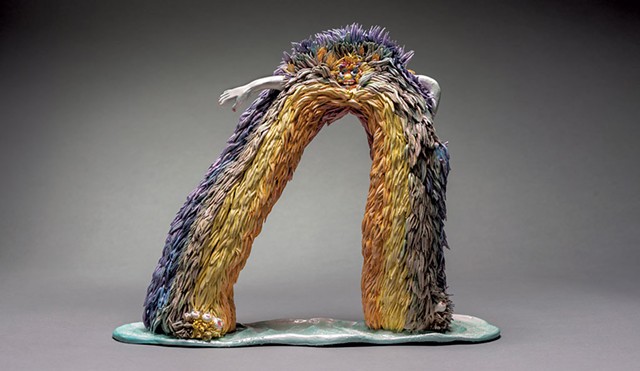
- Courtesy Of Soapbox Arts
- "After the Humans Are Gone: Fantastical Rainbow Monster" by Jennifer McCandless
Ceramicist McCandless, who lives in Burlington, uses quirky humor to alert visitors to environmental degradation, among other concerns. "After the Humans Are Gone: Fantastical Rainbow Monster" is a realistically hairy creature shaped like a rainbow that manages to strike an amusing pose. The title posits a post-human world; the work beside it, "Run Amok: Poseidon's Toxic Fish Pile," a colorful tower of beady-eyed sea creatures, suggests that humans would be responsible.
Bianca Beck's colorful, multi-limbed sculptures — one sited inside and three more on the lawn outside — are positive, even exuberant, explorations of identity. Riffing on the origin myth for romantic longing in Plato's Symposium, which says humans were originally two people split apart by the gods, Beck's creations reunite those halves abstractly, their giant legs expressively bent and joined.
A feminist nonbinary artist, Beck begins a sculpture by shaping chicken wire around a wood armature and wrapping it with papier-mâché. The surfaces, alive with unfettered gestural swaths of acrylic and oil paint, are striking. In 2018, the Portland, Maine, artist told Galerie magazine that the sculptures are meant to "convey the feeling of being doubled or enlarged through partnership, when we become something greater than ourselves."
It bears saying that sometimes paintings are, well, beautiful. Harpswell, Maine, artist Emilie Stark-Menneg's translucent figures of a mother and child either blend into or become landscape; layers of different applications of acrylic — sprayed, brushed, blistered, splattered — make fore- and background indistinguishable. In "Star Kiss," DayGlo colors and a watery atmosphere shot through with light create a dream world that also appears ghostly and anchorless.
The influence of Persian miniatures startles in Iranian American artist Arghavan Khosravi's anti-patriarchal painting "Glass Ceiling of Underground World." Three female figures, roped or enclosed in a crinoline-like cage — a male figure manipulates one rope — lean or stretch above a corner scene of angelic comfort trapped below two glass ceilings. The acrylic painting's linen-and-cotton canvas becomes the 3D skirt of the foregrounded female figure facing away from the viewer, suggesting a transformation through the materiality of art.
Two more Iranian Americans, the identical twins Farzaneh and Bahareh Safarani (known as the Safarani Sisters), have contributed a "video painting" titled "Emerge." The 51-by-102-inch horizontal oil painting in red hues depicts a woman in a black dress lying on her back on the floor; behind her are two windows screened by a sheer red curtain. A video projection superimposes a ghostly figure on the painted one who slowly shifts her limbs, shoulders and head. The eerie, indeterminate narrative that results could be about political choice (freedom over restriction), wishfulness (action versus submission) or simply twinhood.
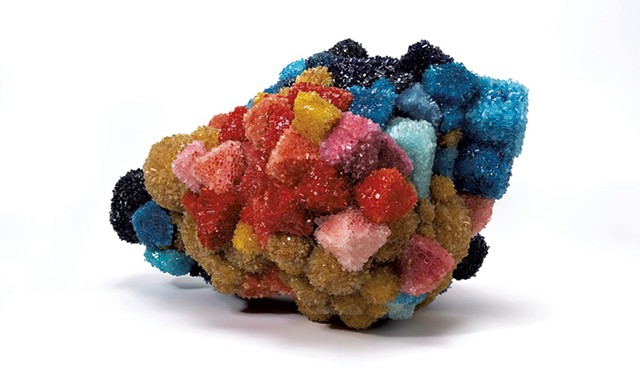
- Courtesy Of Heller Gallery
- "Cinnabar" by Laura Kramer
Resembling bulbous masses encrusted with glass barnacles, Barrington, R.I., artist Kramer's dazzling glass sculptures are problematically beautiful: three, from her "Poisonous Minerals" series, allure with their colors and material while exploring minerals that both heal and hurt. Kramer bolstered her MFA at Rhode Island School of Design with a master's in anthropology and material culture from Columbia University, and the cultural uses of minerals such as cinnabar, tourmaline and sulfur — also the titles of the three works in the series — appear to have captured her imagination.
Red-hued cinnabar, for example, a substance used in Chinese medicine and to create vermillion pigment, also contains mercury; too much cinnabar brings a high level of toxicity. Kramer's work suggests a warning beneath the excess that also appears to be a warning about excess.
Indeed, besides being known for its unsettling imagination, New England is often associated with a penchant for frugality. Paradoxically, "New England Now: Strange States" reveals its own embrace of the ethic of restraint through excess — of beauty, materials, and, in Bauer's choices, the richness and diversity of art from this region.
Correction, May 30, 2024: An earlier version of this story included an incorrect title. Carolyn Bauer is curator.
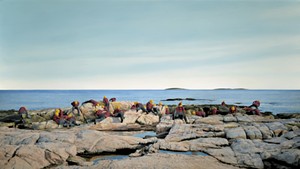






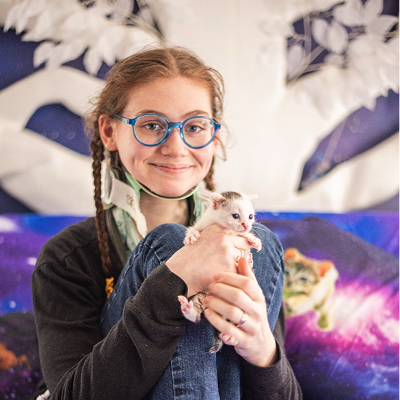
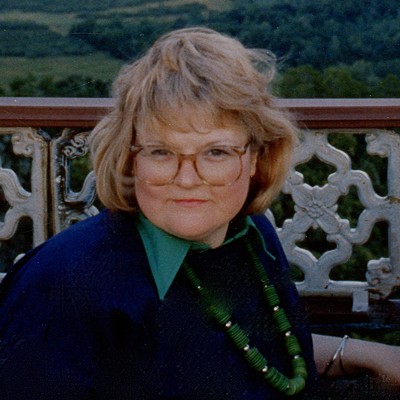

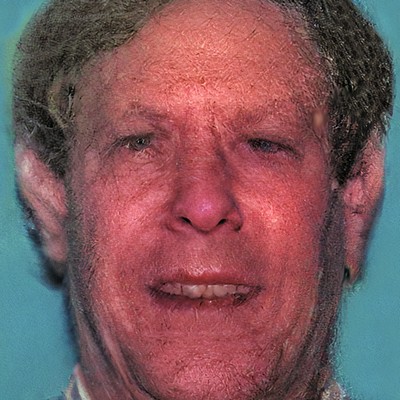
Comments
Comments are closed.
From 2014-2020, Seven Days allowed readers to comment on all stories posted on our website. While we've appreciated the suggestions and insights, right now Seven Days is prioritizing our core mission — producing high-quality, responsible local journalism — over moderating online debates between readers.
To criticize, correct or praise our reporting, please send us a letter to the editor or send us a tip. We’ll check it out and report the results.
Online comments may return when we have better tech tools for managing them. Thanks for reading.